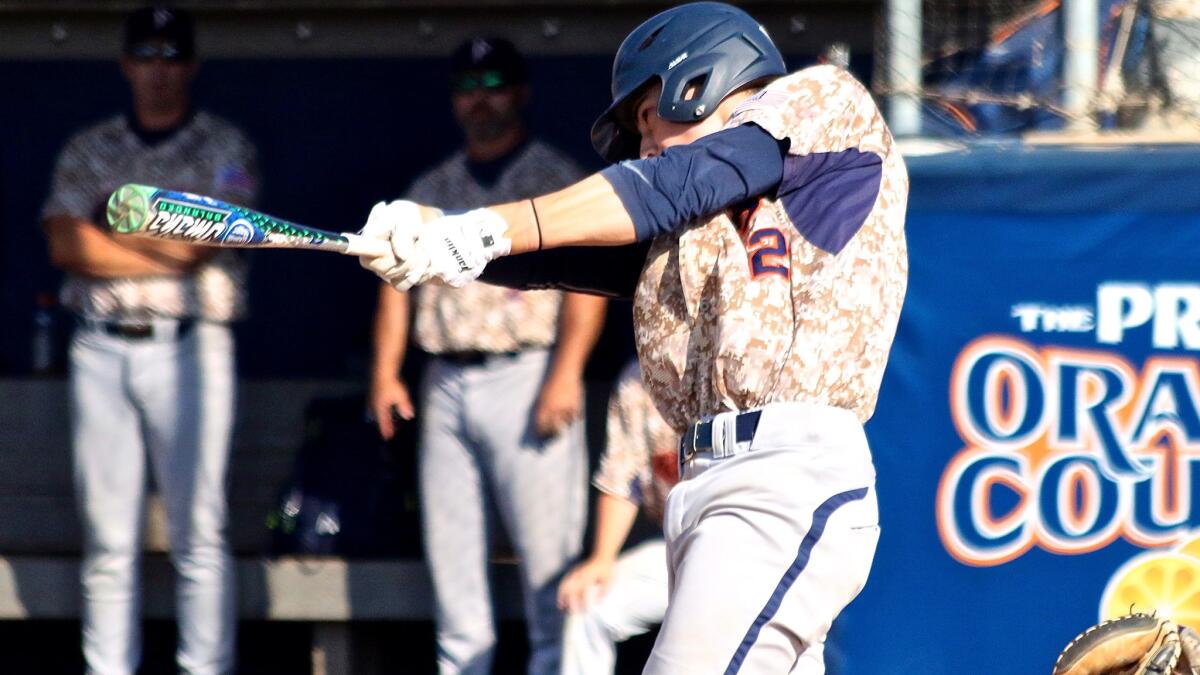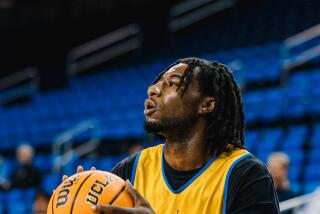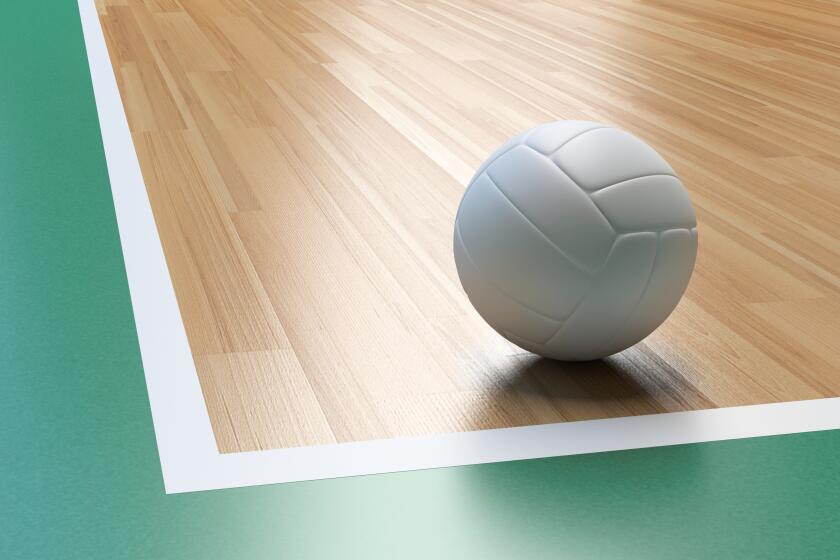New baseball helps college teams regain pop on offense

Pepperdine second baseman Hutton Moyer lines a pitch for a hit against Clemson in the Fullerton Regional of the NCAA tournament on Saturday.
Hutton Moyer, one of Pepperdine’s top hitters, learned things would be easier at the plate this season in the second game.
The Waves were facing Tulane at home, where the onshore gusts are famous for taking the “fly” out of fly balls. In the third inning, Moyer connected.
“It was a first-pitch slider and I got it,” said Moyer, a junior. “I thought, ‘That’s a double off the wall.’ Then it kept going and going and went out. I went, ‘Welcome to the new year and the new ball.’”
Moyer had no home runs in 2014. He has hit 14 this season. Having another season of experience helped considerably, as did bulking up by 15 pounds. But Moyers admits that “three or four” of his home runs were aided by the baseball that was introduced at the college level this season.
The change resulted from an overcompensation after the NCAA enacted rules to tame aluminum bats for safety reasons in 2011. The drop in offensive production brought howls from coaches whose teams traditionally battered pitchers.
The result was a new baseball, one with flatter seams and a slightly harder core, similar to what is used in professional baseball. It increased offensive production this season, but did not bring a return of the numbers created by loaded aluminum bats.
“I think the balance is pretty good right now,” UCLA Coach John Savage said. “I think it is where we want it. We’re seeing better pitchers and better pitching staffs that are performing at a high level. We’re seeing hitters getting rewarded for getting the barrel of the bat on the ball. I think we got it right this time.”
The final testing ground will be TD Ameritrade Park in Omaha, which has replaced Rosenblatt Stadium for the College World Series. TD Ameritrade Park’s dimensions were touted as being the same, but it faced the opposite direction, where the wind worked against batters instead of aiding them.
“Right now, the sample size is small, about 50 games” per team in the regular season, said Savage. “It’ll be interesting to see how it plays out in the regionals, super regionals and College World Series.”
UCLA brought home the 2013 national championship with pitching and defense. There were three home runs hit during the College World Series that year.
A year ago, Vanderbilt won the title and, again, there were only three home runs. The .233 collective batting average was the lowest in the series since 1974, when aluminum bats were introduced.
An average of 33 home runs were hit during the CWS the last 10 seasons it was played in Rosenblatt Stadium.
There were coaches who were not going to stand for the power outage.
Rice’s Wayne Graham fired off a letter to a number of national college baseball writers after UCLA’s title, saying, “The college game is officially out of balance.” He proposed a new ball. In an American Coaches Assn. survey in the fall of in 2013, 87% said that a change to a flat-seamed ball was needed.
“I sort of felt that we were all playing with the same ball, so let’s just go play,” UC Irvine Coach Mike Gillespie said. “However, the statistics were hard to deny.”
The harmony is evident, Gillespie said.
“There is less grumbling,” Gillespie said. “People are probably more at peace.”
The seams on the new ball make it more difficult to command breaking pitches. The tighter core can increase the distance when hit.
But, Gillespie said, “as I watch every game, my take is not, ‘Oh man, that’s a super ball.’ Not yet. It is abundantly clear that there must be 20 more feet on a driven ball.”
The numbers back that up.
There were 2,527 more home runs hit during the 2015 regular season than in 2014, up 28%. The Atlantic Coast Conference went from 326 home runs in 2013 to 530 this season. Only four of the 31 Division I conferences hit fewer home runs in 2014.
“Essentially, if you get it up in the air and hit it well enough, it will get out,” Pepperdine’s Moyer said. “At Pepperdine, it’s hard to hit it out with the way the wind blows. I’ve seen ones hit this year where I went, ‘That’s an out.’ Then it ends up going over the wall.”
Pitching staffs, though, are not being clobbered.
UCLA’s regular-season earned-run average of 2.16 was significantly lower than its 2.55 in 2013, when pitching took the Bruins to the title. James Kaprielian, this season’s ace, got a taste of the lower-seam ball while playing for Team USA last summer.
“It allows you to keep all your pitchers tighter and the breaks are sharper,” Kaprielian said. “Obviously, if you leave a ball up, it is going to fly a little more. Guys who have a tight, hard breaking ball haven’t had a problem. Guys who don’t have had a harder adjustment.”
The final exam will come at the College World Series.,
“This has probably accomplished what it was intended to accomplish,” Gillespie said. “The proof will be in Omaha.”
Twitter: @cfosterlatimes
More to Read
Go beyond the scoreboard
Get the latest on L.A.'s teams in the daily Sports Report newsletter.
You may occasionally receive promotional content from the Los Angeles Times.











